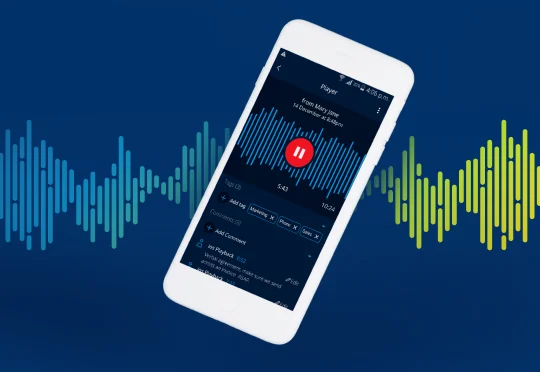

How do you listen?
A business needs to listen to and understand two key groups. Sure, customers are vital, they are, after all, where the revenue comes from. But the front-line employees who determine how customers view your business are also important.
You can build loyalty with both groups and get to know them better by listening to what they say. The big question is how do you listen?
Start by putting humans first
Bots and automation have a place, yet for most of your customers, talking to a real person on the phone remains as important as ever. Want proof? More than seven in ten Americans would rather talk to a human than deal a chatbot or other automated process.
Chatbots and FAQs are best when it comes to dealing with minor queries. When a customer faces a bigger problem, they prefer to speak to a human. That means a phone call.
It’s not hard to see why. We know the three pillars of customer service are; a quick resolution, knowledgeable service agents, and a fast response. Customers feel valued when they speak to a knowledgeable agent who can respond in detail and at length. They want someone to listen to them.
The price of not listening can be high: Three out of four stop using an organisation’s services after a poor customer service experience.
So investing in customer service with a human voice makes good business sense.
Know your customer
Listening to customers makes them feel valued. It also gives you an opportunity to learn more about their needs and wants than you could ever get from an automated system.
By getting to know customers better, you can give them what they want. You can tailor your services, make appropriate offers. This pays off with more customer loyalty and that fuels more revenue.
Most businesses still have a long way to go when it comes to understanding customers. Almost a third of customers say they are frustrated that businesses don’t understand them or their needs.
One of the best ways to improve is by learning from mistakes.
Advances in voice AI and sentiment analysis provide the tools needed to filter negative calls to quickly identify customer complaints, or instances where customer service was lacking.
Understanding what your customers don’t like can be just as important as figuring out what they do. Analysing negative calls can identify areas for improvement – whether across products, services or experiences – and create opportunities for wins. Using data-driven decision making, businesses can increase sales, grow loyalty, and even improve their employee experience by reducing the number of negative customer calls they receive.
Do it right, do it once
One top customer frustration is having to repeat themselves when switching between channels or agents.
When a customer has to run through their problem a second time or repeat their personal details they see their call is not being resolved quickly. It also makes it look as if the person taking their call is not knowledgeable. That fails two of the pillars of customer service.
If you can’t provide a smoother, unified experience, your business will fall behind those who do. This is important if you offer omni-channel service. If you can’t offer it across a single service channel, you’re in trouble.
Pull it all together
Creating a unified customer experience needs a central repository of data from all previous conversations. The smartest way to achieve this is by using cloud native unified call recording that integrates voice data with existing business applications. Voice AI can turn those recorded conversations into a transcript.
When you pull data from previous conversations into a CRM system, data that includes a full transcript, your customer service agents can refer back to earlier conversations. This means customers don’t need to repeat themselves.
In the future consumers want more, not less, human interaction. Your business wants better customer interactions. Technology means you can do both at the same time. Better interactions mean you can make better personalised offers. You can adapt future conversations to the customer’s individual style and remember previous conversations so customers are not asked to repeat themselves.
Engage your staff
Your customer service employees define your customers’ relationship with your business. The more engaged they are, the better your business will perform. They’ll collaborate better and have higher productivity. Engaged workers are more likely to stay and less likely to take time off work. They will be enthusiastic about their work and about your business.
Keeping customer service workers engaged means a better customer experience. It also means cost savings: for a 100-employee organization, a 10 percent improvement in employee retention reduces costs by $50,000. If you can cut your staff turnover from 20 percent to 18 percent, that means two fewer employees to hire and onboard.
Staying engaged with remote working
Your customer service employees are more likely to stay engaged if you make their working life as easy as possible. That means giving them all the tools they need to do their job. This is especially true with remote workers who may miss human interaction.
Be wary of app fatigue. Using too many tools can disrupt workflows and drain productivity. Unified communications helps people stay focused. Most workers prefer the idea of having all communications in one place. Many workers believe a unified platform would help them achieve a better workflow, be more productive at work, and help work feel less chaotic.
Giving your workers a single, central repository of customer interactions will give them the insight they need to provide a better service.
Unified Call Recording and Voice AI
Unified call recording and voice AI will help you listen better to the voices that matter for your business. You’ll have a better understanding of your customers and their needs. At the same time, you’ll have valuable insights into keeping your employees engaged and focused.
Voice AI can bring things to your attention and even expose wants or needs that are not directly expressed. It can give you the information you need to deliver a better customer experience. You can reduce negative calls by learning from complaints. AI software can analyse and identify customer sentiment alerting you to problem areas. Positive calls can help you train staff and identify the best performers.
You can integrate AI voice and call recording into unified communications platforms and CRM to capture information at every customer touch point. This has the added benefit of easing app fatigue with your employees.
You can become a better listener by delegating some of the listening to Voice AI

